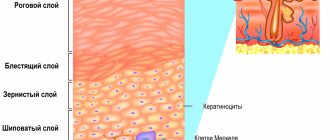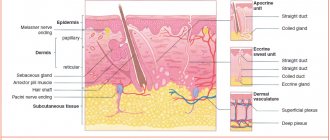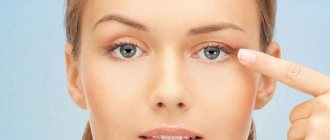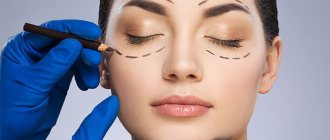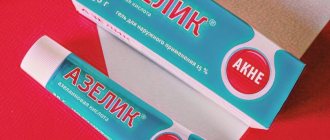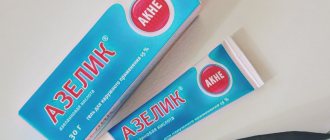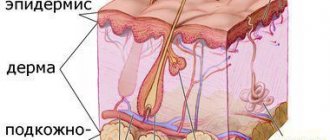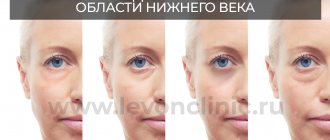Everyone sees the concept of “sensitive skin” differently. Some consider their skin to be sensitive because even after a short exposure to the sun, it instantly burns to redness. The latter do not like the fact that their skin is very sensitive to various cosmetics. And each of them, of course, is right, because such characteristics indicate the tenderness or sensitivity of the skin.
Tenderness, vulnerability, tendency to allergic reactions... Usually dry skin has such innate properties. Whereas normal and fat ones behave more steadfastly. But this characteristic is not constant. Over time, even previously resistant skin can become vulnerable.
Introduction
At dermatological appointments, the doctor often encounters patient complaints about a feeling of discomfort in the facial area in the form of burning, tingling, as well as poor tolerance of cosmetics. In this case, visible inflammation on the skin may be absent or minimal. The described picture is characteristic of sensitive skin (SC).
Currently, the term “sensitive skin” refers to the increased reactivity of the skin in response to external and/or internal stimuli [1–3].
Each person's skin sensitivity is perceived subjectively, and visible symptoms may or may not be present. There are several classifications of Cheka. Classification by T. Yokota et al. includes 3 skin types based on the preservation of barrier functions and the presence of inflammation [4]. The classification by A. Pons-Guiraud considers PC from the standpoint of susceptibility to exogenous (environment), endogenous (chronic diseases, emotional factors) factors and the effects of cosmetics [5]. The greatest practical application, in our opinion, is the classification of skin types according to L. Baumann [6]: acne type (S1), rosacea type (S2), stinger type (S3) and skin type prone to the development of contact dermatitis ( S4). Using this classification helps to determine the cause of hypersensitivity of the skin and select the optimal treatment and care.
Patients with acne often report increased skin sensitivity. The use of aggressive or incorrectly selected cleansers, the use of keratolytic components or external preparations containing retinoids leads to disruption of the skin barrier functions. The irritating effect of sebum and microbial waste products enhances these disorders. It is impossible not to take into account the comedogenic effect of a number of ingredients in cosmetic care products and decorative cosmetics, which aggravate or aggravate the course of acne. Among the substances with comedogenic properties, the most common are avocado oil, cocoa butter, coconut oil, evening primrose oil, lanolin, soybean oil, red dyes (blush, lipstick), isocetyl stearate (emollient). In the clinical picture, patients with this type of skin sensitivity present typical manifestations of acne in combination with complaints of burning, redness of the skin that occurs upon contact with water and cleansers, as well as when applying cosmetics.
A mandatory symptom for all clinical subtypes of rosacea (erythematotelangiectatic, papulopustular, phymatous and ophthalmic) is inflammation [7]. Patients complain of facial redness after exposure to irritating factors (hot drinks, spicy foods, sunlight, heat, etc.). When using local products, patients note burning, tingling, and often worsening of the skin condition [8].
The stinger type of skin sensitivity is characterized by a burning sensation mainly in the area of the nasolabial folds and cheeks when applying cosmetics. Subjective sensations are not accompanied by clinical manifestations. The reasons for the increased sensitivity of the area of the nasolabial folds and cheeks are the greater permeability of the stratum corneum, the many sweat glands located here and a large network of sensory nerves [9]. Patients with this type of sensitivity are called “stingers” (English stinger - sting), this term was proposed by A. Kligman in 1977. This type of skin is also called “reactive”, “irritable” [10]. The skin barrier plays an important role in protecting against irritants. It is believed that skin with impaired barrier function has increased permeability to substances applied to it, which can cause a tingling sensation. The list of the most common substances in cosmetics that cause tingling [11] is presented in Table. 1 .
Table 1. Substances that can cause a tingling sensation
| Avobenzone (Parsol) - UVA sunscreen filter | Capsaicin |
| Alcohol | Menthol |
| Azelaic acid | Lactic acid |
| Benzoic acid (preservative E210) | Peppermint |
| Vitamin C | Salicylic acid |
| Witch hazel | Sorbic acid (preservative) |
| Glycolic acid | Eucalyptus oil |
The next type of skin sensitivity (S4) is characterized by a tendency to develop contact dermatitis. Climatic conditions (cold, wind), frequent contact with water and detergents (visiting a swimming pool), low indoor air humidity lead to a weakening of the barrier properties of the skin. Against this background, the use of cosmetics with potentially irritating substances (Table 2) facilitates the formation of contact or allergic dermatitis. For patients with this type of sensitivity, it is especially difficult to choose the best skin care products.
Table 2. Irritating and sensitizing substances
| Ingredient | Cosmetic product |
| Quaternium, thimerosal (preservative) | Mascara and eyebrows, eye shadow, blush, cleansing solutions |
| Formaldehyde (preservative) | Nail strengtheners, manicure varnishes |
| Propylene glycol (solvent) | Deodorants, cosmetic masks, creams |
| Parabens (preservatives) | Cosmetical tools |
| Peruvian balsam (flavor) | Lotions, makeup remover solutions |
The main pathophysiological mechanisms of BC formation are damage to the hydrolipid mantle, leading to disruption of the skin barrier, and ceramide deficiency, causing a decrease in corneocyte cohesion. Both mechanisms lead to increased permeability of the epidermis to irritants, increased transepidermal water loss (TEWL) and, as a consequence, to the formation of inflammation (release of substance P, vasodilation, degranulation of mast cells) [12].
A rational selection of daily facial skin care products can reduce the risk of developing CC, as well as reduce the severity of symptoms of an existing disease. Priority should be given to cosmetic products for the care of CC. Such medicinal and cosmetic products should be well combined with external medications and have a synergistic effect on suppressing the main pathogenetic mechanisms of BC formation.
One of the most effective and in demand in the practice of a dermatologist is the Topicrem brand of medicinal cosmetics. The innovative products in this range are the products from the Topicrem Calm+ line, designed to correct hypersensitive skin. The line includes soothing micellar water and skin hydration products, presented in three textures: fluid, light cream and rich cream. Micellar water contains a soft surfactant (surfactant) based on coconut oil in a very low concentration, sufficient for the formation of micelles. It provides effective skin cleansing and maintains maximum skin barrier integrity. Micellar water also soothes the skin around the eyes and is adapted for contact lens wearers [12]. Moisturizers contain ingredients that affect the main pathogenetic mechanisms of skin sensitivity. Sunflower unsaponifiable oil increases ceramide synthesis and has a soothing effect on the skin by reducing cytokine production [12]. Plum oil, rich in omega-9 unsaturated fatty acids, restores the lipid mantle and thereby reduces TEWL. Glycerol organizes lipid layers and restores intercellular cement. The calming effect of allantoin reduces subjective sensations in the form of burning, tingling, and a feeling of skin tightness.
All products in the Topicrem Calm+ line do not contain fragrances, dyes, or alcohol, and undergo safety and quality control according to pharmaceutical standards during the production process.
The purpose of the study was to evaluate the clinical effectiveness and safety of the Topicrem Calm+ cosmetic line for various types of skin sensitivity.
Sensitive skin care
Care for sensitive skin consists of the following procedures:
- Cleansing. In the morning you need to wash your face with warm spring or mineral water, and in the evening use soft cleansing milk, which will remove makeup and dirt. The skin also needs to be wiped with a tonic, which makes it possible to tone and refresh the skin;
- Hydration. In the morning, you need to apply a day cream to the skin, which contains weakening fats and nutrients, and also has protection against ultraviolet radiation. It is best if the cream is created with mineral elements based on thermal waters;
- Night care. Before going to bed, a layer of cream is applied to the skin, which has regenerating properties and certain elements that guarantee reliable protection and moisture accumulation, while activating oxygen exchange in cells;
- Decorative cosmetics must be tested for hypoallergenicity;
- Face masks. For those with sensitive skin, it is best to give preference to easily washable masks that are endowed with moisturizing and nourishing properties. It is not recommended to apply the mask to people with incompatibility with any of its components.
Sensitive skin needs constant hydration and protection, which can be provided by cosmetic products that are optimally suited to your skin type. It is necessary to limit the use of masks, mesotherapy, peeling and other skin-damaging procedures, as well as learn how to use and choose decorative cosmetics correctly.
Material and methods
The study included 40 patients aged 18-60 years (5 men and 35 women) with various types of skin sensitivity (Fig. 1) . The majority (48%) were patients with a skin type prone to contact dermatitis (S4). All patients were under outpatient observation.
Rice. 1. Distribution of patients with different types of skin sensitivity.
Criteria for inclusion of patients in the study:
— patient age over 18 years;
- diseases accompanied by increased skin sensitivity (rosacea; seborrheic dermatitis; perioral dermatitis; simple irritant dermatitis; acne);
— availability of informed consent to participate in the study.
Exclusion criteria:
— age of patients under 18 years old;
- use of topical corticosteroids less than 1 month before the start of observation;
— somatic diseases in the acute stage;
- mental disorders.
The observation lasted 14 days, patients were given a skin care guide. All patients used Topicrem Calm+ soothing micellar water as monotherapy 2 times a day, followed by application of a moisturizer in a texture appropriate to their skin type. Examination and assessment of clinical manifestations on the skin were carried out on the 7th and 14th days of treatment, the dynamics of the main symptoms were assessed by comparing photographs taken on the 1st and 7th days of treatment.
During the study, patients were surveyed, in which patients, based on 3 criteria (does not irritate the skin, does not leave an oily sheen or stickiness, makes the skin soft), assessed the cosmetic acceptability of care products (micellar water and moisturizer). For each criterion 1 point was awarded. If the patient met all 3 specified criteria, the product was rated “excellent” (3 points), 2 criteria - “good” (2 points). If the patient met only 1 criterion, the cosmetic acceptability of the product was assessed as unsatisfactory (1 point).
Diagnostics
Since there are no external manifestations, it is impossible to independently determine the cause of the pathology, and without this it is impossible to use folk remedies or medications. In such a situation, self-medication can provoke even greater health problems, so you cannot do without qualified help. It is best to contact a local physician, who, after an initial examination and history taking, will refer you to a specialist.
A thorough examination is required to identify the cause of the pain.
Most often, this problem is dealt with by a neurologist. If the damage to the nerve endings is caused by diseases of the spine, you will additionally need to consult an orthopedist or vertebrologist. To identify pathology, the patient is prescribed magnetic resonance or computed tomography, radiographic examination, and electromyography. A general and biochemical blood test is also carried out, which makes it possible to determine the presence of infectious pathogens, sugar levels, and determine the body’s need for microelements and vitamins. Based on the results of a complete examination, the doctor selects individual therapy for the patient.
results
Patients with acne-type skin sensitivity (n=5) used the Topicrem Calm+ line for increased skin sensitivity that developed during external or systemic anti-acne therapy. On the 5-7th day of therapy, all patients showed a decrease in the intensity of symptoms, and on the 10-14th day - their complete regression.
Clinical case 1. An 18-year-old female patient complained of a burning sensation, a feeling of skin tightness and redness of the facial skin. Since the age of 16, the patient has been bothered by acne on her face. Burning and redness of the facial skin appeared on the 5th day of using the drug for external treatment of acne (adapalene gel).
Status localis. On the skin of the face (forehead, cheeks, chin) there are multiple closed comedones, inflammatory papules, single pustules, as well as pink erythema, the location of which coincides with the areas where the therapeutic gel is applied. In the erythema area there is slight peeling of the skin. Diagnosis: acne vulgaris (L.71), simple irritant dermatitis caused by drugs (L.24.4). It is recommended to temporarily cancel external treatment. Medical and cosmetic care was prescribed in the form of monotherapy with Topicrem Calm+ (micellar water, light cream). A significant reduction in symptoms was noted on days 5-7 of treatment (Fig. 2) .
Rice. 2. Acne type (S1) skin sensitivity.
a - before treatment; b — after 7 days of treatment with Topicrem Calm+.
Ten patients with rosacea-type skin sensitivity (mainly with the erythematous-telangiectatic stage), using Topicrem Calm+ products, noted a rapid regression of subjective sensations (on the 2nd day) and a significant decrease in the intensity of skin manifestations by the 7-10th day of therapy.
Clinical case 2. A 45-year-old patient complained of episodes of transient redness of the skin under the influence of emotional and nutritional factors, burning of the skin upon contact with water, and rashes on the skin of the cheeks. Considers himself sick for 1 year. It was not treated independently, the rash periodically regressed spontaneously. Recently, the skin process has become persistent.
Status localis. On the skin of the cheeks there is diffuse erythema of a pale pink color, against which isolated bright pink papules with a diameter of up to 0.3 mm, single finely looped telangiectasias and slight peeling in the cheek area are observed. Diagnosis: rosacea (L.71). Based on your skin type (combination type with increased oiliness in the T-zone), micellar water and Topicrem Calm+ light cream are prescribed. The patient noted the disappearance of subjective sensations in the first days of using the cream. A significant regression of skin rashes was observed on the 7th day of treatment (Fig. 3) . The patient continued to use cosmetics after the end of the observation period.
Rice. 3. Rosacea type (S2) skin sensitivity.
a - before treatment; b — after 7 days of treatment with Topicrem Calm +.
There were 6 patients with S3 type of skin sensitivity under our supervision. Selecting care products for patients with this type of sensitivity is a difficult task. The correct selection of moisturizer texture based on skin type is of fundamental importance. Sometimes the wrong choice of care product causes negative effects.
Clinical case 3. A 35-year-old female patient complains of burning and redness of the skin of the nasolabial folds when applying cosmetic cream, and a feeling of skin tightness after washing. I asked for a selection of facial skin care products. Status localis. There are no rashes on the face, the skin is pale and dull. In the T-zone, enlarged pores, increased greasiness, and oily shine are observed. There is fine peeling on the entire surface of the facial skin. Taking into account the combination skin type, dehydration and hypersensitivity of the skin, therapeutic and cosmetic care using Topicrem Calm+ cosmetics (micellar water and light cream) was prescribed. On the 2nd day of treatment, the patient noted the appearance of rashes on the skin of the forehead (Fig. 4) , increased greasiness in the area of the nasolabial folds and chin. It is recommended to change the form of the cream to a fluid, with the use of which a rapid regression of rashes and the disappearance of subjective complaints were noted. The patient continued cosmetic care using Topicrem Calm+ fluid.
Rice. 4. S3 type of skin sensitivity. Exacerbation after using light cream Topicrem Calm + .
The majority of observed patients (n=19) had type 4 skin sensitivity (S4), prone to contact dermatitis. In all patients, the use of Topicrem Calm+ products was found to be highly effective. Subjective sensations (feeling of tightness, burning) regressed on the 2-3rd day of therapy, clinical manifestations - on the 7-10th day of treatment. By the end of the observation, the appearance of the skin also improved: dullness, even color and freshness of the skin appeared, peeling regressed.
Clinical case 4. A 45-year-old female patient complains of a feeling of tightness and tingling of the skin when exposed to adverse weather conditions and contact with water. The duration of the disease is more than 5 years. Rashes began to appear on my face periodically.
Status localis. The skin of the face is matte, the pores are narrowed. On the skin of the cheeks and temporal areas there are multiple erythematous spots with a diameter of 0.5 to 1 cm, with blurred boundaries. There is slight peeling on the surface of the spots. Diagnosis: simple irritant dermatitis (L.24), weather-dependent (Fig. 5) . Taking into account the dry skin type, the patient was prescribed therapeutic and cosmetic care with Topicrem Calm+ using micellar water and rich cream. A rapid regression of subjective sensations was noted after 1 day. By the 7th day, the symptoms of dermatitis and peeling regressed, and the appearance of the facial skin improved. The patient continued cosmetic care.
Rice. 5. S4 skin sensitivity type.
a - before treatment; b — after 7 days of treatment with Topicrem Calm+.
During the survey, the majority of patients highly rated the products of the Topicrem Calm+ cosmetic line (39 patients when evaluating micellar water and 33 patients when evaluating moisturizer). Only 2 patients gave an unsatisfactory assessment when using a moisturizer (the appearance of “irritation” of the skin, increased oiliness), which is due to the incorrect choice of its texture (Fig. 6) .
Rice. 6. Subjective assessment by patients of the tolerability of cosmetics. Excellent (3 points), good (2 points), unsatisfactory (1 point).
How does pain syndrome manifest itself?
Allodynia has very characteristic manifestations by which it can be easily recognized. First of all, this is a painful reaction to irritants that previously did not cause any unpleasant sensations. That is, if suddenly the skin on your back begins to hurt from touching clothes, bed linen, from jets of water while taking a shower or, for example, from the wind, this already indicates a pathological increase in sensitivity. The nature of the manifestations also helps to determine the disease:
- when exposed to an irritant, a sharp, often unbearable pain appears on the surface of the skin;
- pain can be localized in one area, but more often spreads to the entire back or most of it;
- At the same time, a tingling sensation is felt in the skin, itching, a crawling sensation, and a burning sensation may occur;
- pain syndrome bothers you with any movement, prevents you from relaxing and falling asleep;
- It is impossible to lie on your back and sit leaning on the back of a chair.
Sore skin on the back makes it difficult to sit normally
The person becomes overly irritable, insomnia appears, and headaches often occur. All this leads to increased fatigue, nervous tension and causes the development of serious complications in the cardiovascular, digestive and nervous systems.
Keep your skin soothed
If your skin is already sensitized, it is important to cool the skin and calm the inflammatory response as quickly as possible. Many natural ingredients can be very soothing to quickly relieve facial redness. These include calendula extract, rich in saponins and flavonoids, chamomile extract, rich in bisabolol and chamazulene, centella asiatica extract, rich in madecassoside and asiaticoside.
Your first action should be to apply a gentle preparation rich in these ingredients, such as our ORMEDIC Soothing Gel Mask . This cooling mask contains powerful extracts that work together to quickly improve the appearance of sensitive and inflamed skin, while also infusing it with firming moisture.
Types of Numbness
Depending on the disease that provoked the syndrome, numbness can affect different parts of the body:
- If the cause is a pathology of the brain, the loss of sensitivity will affect the limbs on the opposite side. So, if the right hemisphere is damaged, the left leg or arm will suffer.
- With diseases of the spinal cord, numbness occurs in the area located below.
- Polyneuropathy provokes the “gloves and socks” syndrome.
- If the culprit is a peripheral nerve, the person will feel a loss of sensitivity in a finger - for example, the little toe on the foot, or the big toe - in the area of innervation.

